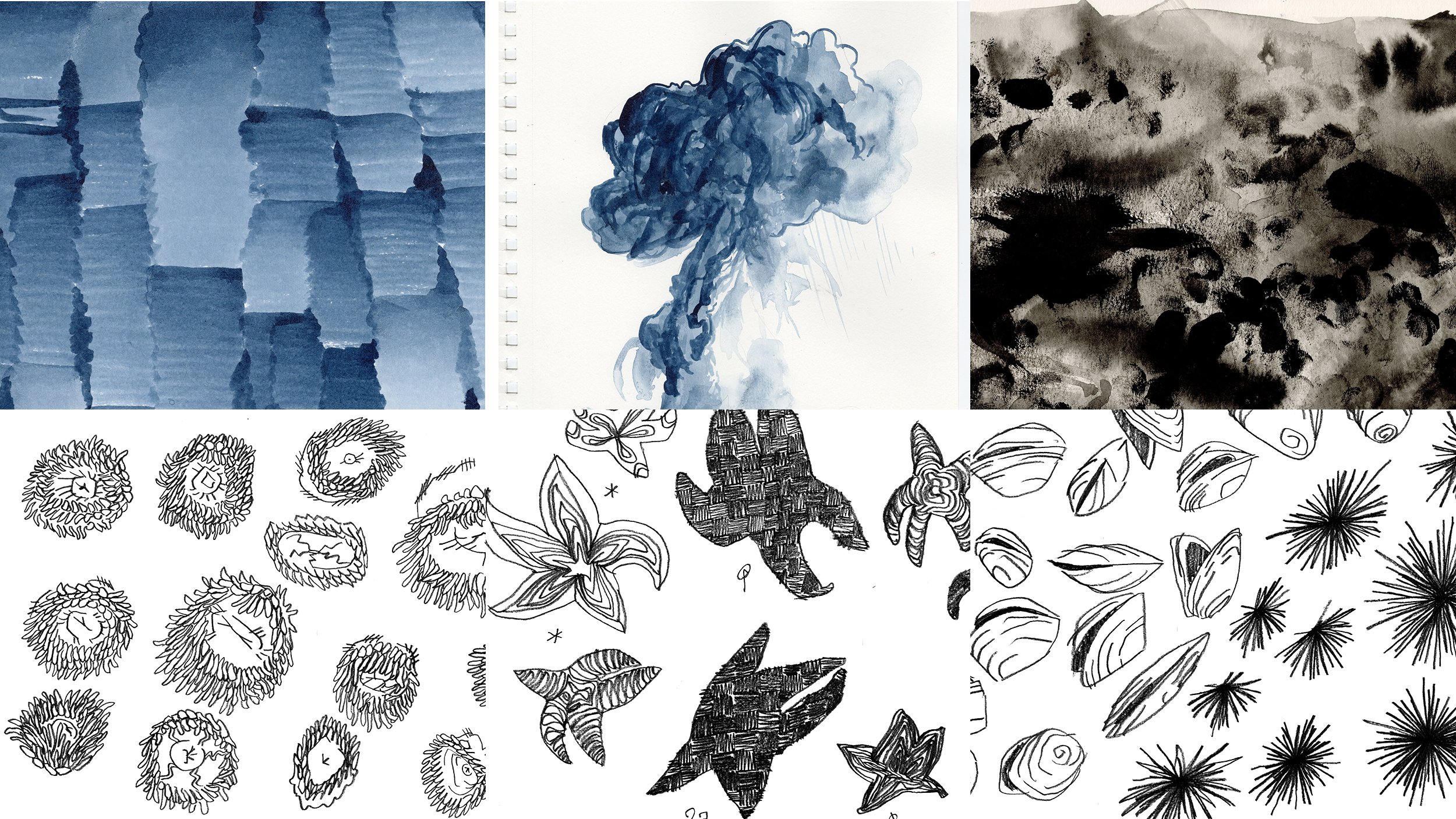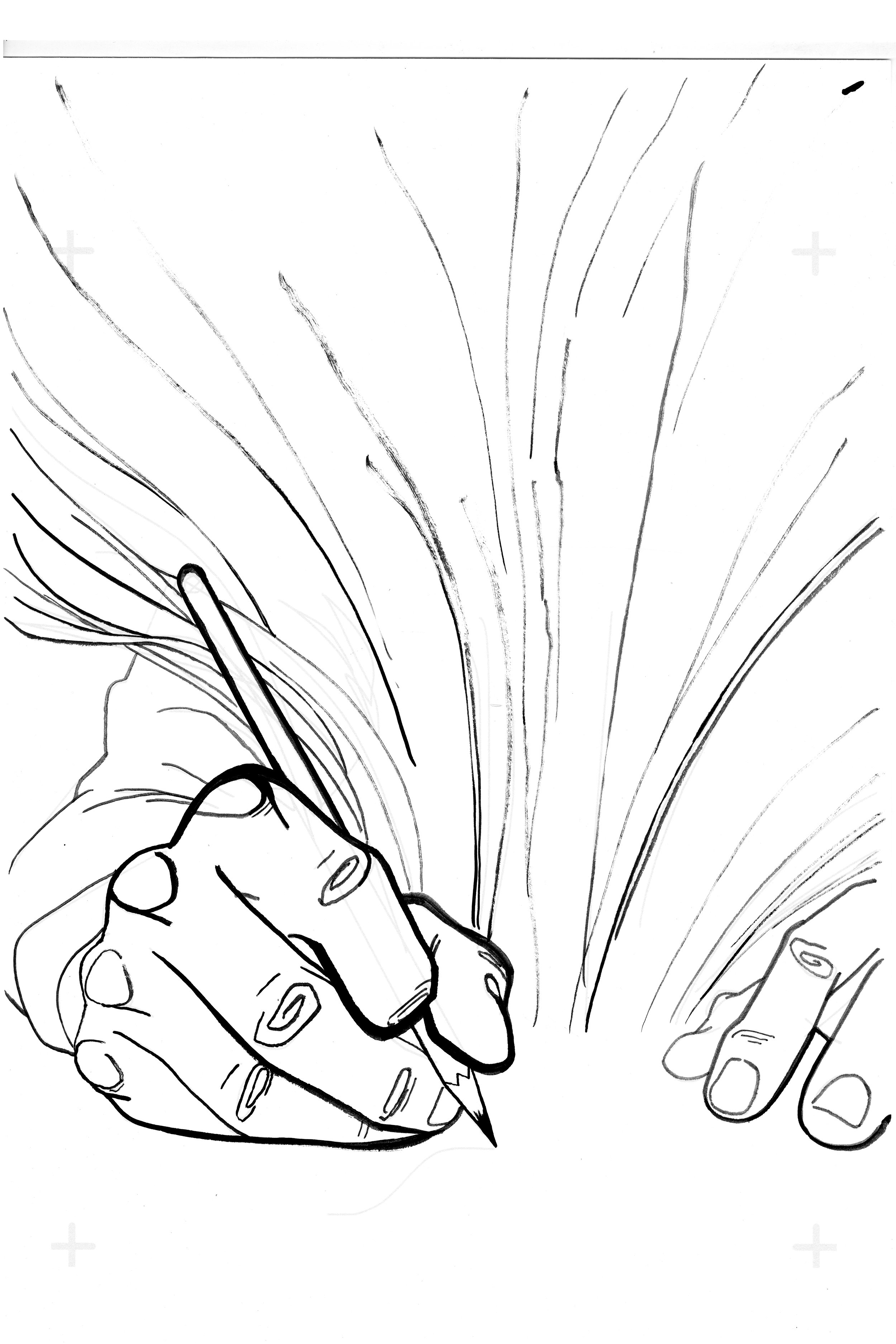
Overview Effect
Or, how to find hope and belonging in an unimaginably vast universe.
“Overview Effect”.
36” x 48”. Acrylic ink and paint on illustration board, Photoshop. 2023.
ABSTRACT
“Every one of us is, in the cosmic perspective, is precious. If a human disagrees with you, let him live. In a hundred billion galaxies you will not find another.”
-Carl Sagan, “Cosmos”
THE SHORT OF IT
“Overview Effect” was a central piece during my final semesters at ArtCenter College of Design. It’s the culmination of a long geneaology of thinking on my part regarding the rarity and preciousness of life in the universe. As expanded upon further below, it’s name references an experience astronauts have reported when they observe our home planet from the outside looking in. It’s a transcendental experience that highlights how precious the Earth and the existence of life is, and how vast, cold, and empty the rest of the universe appears. I sought to capture some of that love for life and our planet in this piece.
“Overview Effect” was created by painting a collage of various animals on illustration board with black acrylic ink and paint. It was painted at the size the final poster would be printed at, 36” wide by 48” tall. As you’ll see in the process section below, the illustration board was sliced into sections small enough to scan at high resolution. Color was added in Photoshop once the image was reassembled. The final poster was printed and mounted on foamcore backing.
THE LONG OF IT
Why do we exist? Where do we belong? What happens after we die? Is there a Creator? If so, why do evil and suffering exist? Does life exist elsewhere in the universe?
These are haunting and moving questions as old as the human species. I think it’s likely early man asked the same things, more or less, as they gathered with family around campfires at night, drawing close together to form a line against whatever lay in the dark unknown around them.
When I consider these sorts of things (and I consider them ALOT), I find my breath catches in my throat, or I recall a memory with mom or dad or my brother and sister, or a long-lost friend, an ex, a relationship that once was but no longer is.
The place these questions lead me to is one that seeks to understand the basic nature of the universe, and of life. Is there any inherent reason we exist? Is the universe just an empty place, devoid of any of the logic or meaning we so crave from it, and is life simply competition, murder, thievery, power grabs, survival of the fittest? Could this be a place where purpose, and belonging can be forged, and where in addition to the brutal and merciless laws of life and evolution, cooperation and understanding can offer a path forward for our species? As strange and huge as life is, it’s possible that all these contradictory things may be true at the same time.
The overview effect is something that can be experienced when we become aware of how tiny and fragile our place in the universe is. Suddenly every dispute, conflict, every resentment, prejudice, or difference of opinion becomes enfeebled and appears utterly insignificant in the face of our shared reality: that we are a very young species, craving human things like love, dignity, and understanding on this planet, which is itself a miniscule raft of life hanging in an endless ocean of silent, indifferent darkness.
As explored further below, it was within the “Overview Effect” pieces that I sought to capture some of these soaring joys and icy anxieties.
Research
The initial seed of this project began as a biographical piece on Rachel Carson, a biologist, chemist, and writer who published her seminal work “Silent Spring” in 1962. This work, which critiqued the widespread use of pesticides such as DDT throughout post-World War II America, is widely regarded as the genesis of the modern environmental movement.
Dr. Carson wrote at the height of the Cold War. Most of us born after the fall of the Soviet Union in the early 1990s probably don’t truly understand the absurdity and hysteria of the Cold War era, when the United States and the Soviet Union stood on the brink of annihilating each other through nuclear warfare.
The onset of the Cold War coincides with what many modern scientists dub ‘the Anthropocene’, which is defined as the geologic age where humanity has had a significant impact on Earth’s geology and ecology. Although there is no absolute consensus when it began, many scientists use one event to mark the beginning of the Anthropocene: the Trinity test, the first detonation of a nuclear weapon, conducted by the Manhattan Project in July 1945.
During the Second World War and continuing on into the late 1940s, 50s, and 60s, an attitude of ‘scientism’ dominated Western society: the idea that nature was meant to be ‘beaten back’ and subjugated into submission by mankind using the vast technological, chemical, and industrial advances the nuclear age had ushered in. Furthermore, the postwar economic boom that Americans enjoyed engendered a deep-seated belief that a better life, social status, and increased personal happiness were commensurate with consumerism and material wealth. Owning more appliances, larger cars, and owning a home in the suburbs were social markers of having “made” the American Dream.
It was against these deeply entrenched social attitudes that Rachel Carson urged caution against in '“Silent Spring”. It depicted a vision of a world where no new birds would be born due to the indiscriminate spraying of pesticide on all vegetation, which not only killed insects but softened and deteriorated bird eggshells so they could not survive to hatch.
A conservation and proto-ecological consciousness already existed prior to “Silent Spring”, perhaps tracing back to the foundation of America’s national parks during the late 1800s and early 1900s. But reality was different, and very absurd, during the Cold War: human extinction was now possible through the use of nuclear weapons. In addition, the rampant superficiality and consumerism of postwar America meant that many people were eager to find some validation for the alienation and disillusionment they felt in the societal values of the day.
After it was published in 1962, Dr. Carson faced persecution by industrial and chemical companies such as DuPont and Monsanto. Typical of the time, they attempted to use the fact that Rachel Carson was a woman to cut the legs out from beneath her thesis. It went hand in hand with a mostly male, mostly ‘left-brained’, ‘rational’, ‘logical’ scientific community that a woman could hardly understand biology, chemistry, or industry.
Dr. Carson withstood all of these attacks even as she battled with cancer. She eventually passed away in 1966, but her cause had been taken up by some powerful and influential figures which included President Kennedy, who had his own scientific panel test Carson’s methods and found them perfectly sound. As a result of the consciousness she has raised with “Silent Spring”, throughout the remainder of the 1960s and 70s, alongside the civil rights movement and other identity movements such as second-wave feminism and the modern gay rights movement, the contemporary environmental movement was born.
PREVIOUS ITERATIONS

Other pieces in this biographical series sought to evoke the period Rachel Carson lived in by evoking nuclear mushroom clouds, as well the realm of her passionate biological study during the 1940s and 50s: tide pools and the diverse flora and fauna within.

The first instance of the jigsaw of animals that evokes the complex tapestry of life on earth. This was part of the 'Indra's Net' concept, where every animal would form an interconnected 'net' of life.

I attempted to create an image that blended Dr. Carson's love of the ocean and her love of writing into one. Notice the trim marks at the top of the image, which I would use to trace another layer of imagery on top of the bottom drawing of hands. All layers would be scanned and compiled together in Photoshop.

Mussels and urchins are hand-drawn, scanned, and digitally painted for the tidepool image.

Sea anemones.

Myriads of starfish in all sorts of shapes and designs.
Images of nuclear explosions evoking the fear and anxiety of the nuclear age Rachel Carson wrote at the height of. Painted on watercolor paper, colors manipulated in Photoshop.

For the 'Indra's Net' image, I wanted to evoke a 'divine design' for the interconnectedness of life. I thought of what "looking at god" might be like to describe the patterns and rhythms of the universe. Geometry, fractals, non-human order, symmetry, and patterning seemed to me to be the right way to depict the universal and the divine. I may have been thinking of Buddhist and Hindu concepts, but also of Islamic depictions of god which would never describe human imagery, instead choosing to illustrate complex and lush patterns.

The first spread in the biographical series of images on Dr. Carson sought to evoke a spread in a science editorial like National Geographic.

Another spread laying out the social and cultural context in which Rachel Carson wrote. The background image is a nightmarish vision of the first minutes of nuclear war.

In the 'Indra's Net' spread, the divine net of life forms a pattern behind the jigsaw of animals on the left. On the right, a newborn baby floats on a node of the divine net. It sought to illustrate that humans are not separate from nature and not masters, but are as much a part of the complex web of lives as all other organisms are.

The final biographical image for Dr. Carson depicted a kaleidoscope of tidepool life blended with her love of writing. Her writings brought her passion for biology and empathy for life to many others.
PROCESS
ALL VERSIONS + ALTERNATES
APPLICATIONS
I imagine an “Overview Effect” poster might be particularly at-home around zoos, arboretums, parks, green spaces, and other similarly open and natural environments were people can find some communion with nature.














